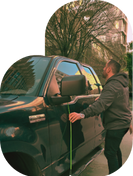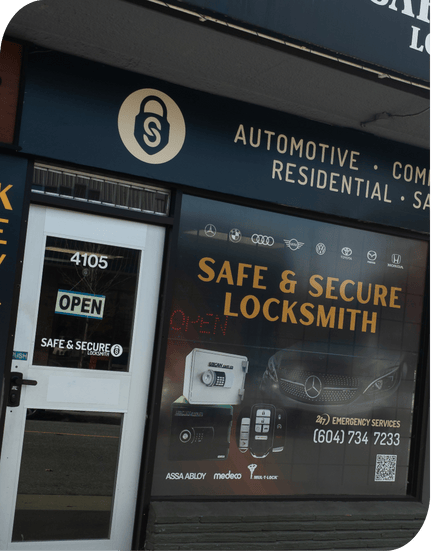A Locksmith for your car, home, and business
Emergency Locksmith Vancouver
Need an emergency locksmith in Vancouver? Our mobile team handles everything from lockouts, to increasing the security of your business, keys, fobs, and more.

Have an Emergency?
Auto, residential, or your business.
Safe & Secure is the trusted choice.

For over 30 years, we’ve been keeping Vancouver safe and secure, proudly serving our community with care and dedication.

How to Book a Locksmith
Call (604) 734-7233
If you have any questions or want to book a appointment, call us and we will connect you to one of our locksmiths.
Book a Service Online
Select the locksmith service you are looking for and book a date and time. We will contact you to confirm before your appointment.
Visit our Vancouver Locksmith Shop
Drop by Safe & Secure Locksmith at
4105 Macdonald Street in Kitsilano, Vancouver, BC.
Emergency Locksmith Services
Residential Services
Automotive Services
Commercial Services
- High-security lock installation
- Target hardening
- Safe and vault access
- Business lockout
Why Choose Safe and Secure Locksmith
Fast Response
Our team provides fast response times across Vancouver and the lower mainland.
24/7 Emergency Locksmith
We are available around the clock to assist with emergency locksmith services.
Licensed
Professionals
Our team consists of highly trained and licensed professionals.
Frequently Asked Questions.
Check out our FAQ section for quick answers to common questions about our 24/7 locksmith services, online shop, and more!
Are your locksmith services available 24/7 in Vancouver?
Yes! Safe & Secure Locksmith offers 24/7 emergency locksmith services across Vancouver and nearby areas. Whether it’s a car lockout, lost key, or broken lock, our mobile locksmiths are always on standby day or night to get you back inside quickly and safely.
Do you offer mobile locksmith service for emergencies?
Absolutely. Our mobile locksmith team is equipped to handle emergencies anywhere in Vancouver, from vehicle lockouts to home rekeying and key replacements. We bring all the tools and technology right to your door, saving you time and stress.
Where is the Safe & Secure Locksmith shop located, and what are your hours?
Our locksmith shop is located in Kitsilano, Vancouver, and open Monday to Friday from 8:30 AM to 5:00 PM. You can stop by to duplicate keys, repair locks, or browse security hardware. Need help after hours? Our 24/7 mobile locksmiths are just a call away.
Are all your locksmiths licensed?
Yes! Every locksmith at Safe and Secure Locksmith is fully licensed, ensuring you receive professional, trustworthy, and reliable service every time.
Can you make or program car keys on-site?
Yes, our automotive locksmiths can cut and program car keys on-site, including smart keys, transponder keys, and fobs for most makes and models. Whether you’ve lost all your keys or just need a spare, our mobile car key service comes straight to you.
How quickly can a technician arrive for emergency lockout service?
In most cases, our emergency locksmiths arrive within 20 to 30 minutes, depending on your location in Vancouver. We prioritize urgent calls like car, home, and office lockouts, ensuring fast and professional assistance whenever you need it.
Service Areas
Looking for a locksmith near you? We cover all of Vancouver and the lower mainland. For a full list of the areas we serve, please use the drop-down menu below.
Articles and Blog.
Our blog covers everything from lock maintenance to cutting-edge security solutions, ensuring your home and business are always protected.
What our Customers are Saying.
Trustindex verifies that the original source of the review is Google. The guy was professional, polite, and reliable. He copied a Fobkey for my Doge Carvan, and the price was amazing. I highly recommend this place for the car key.Posted onTrustindex verifies that the original source of the review is Google. Very accommodating with appointment times. Locksmith did a super good job. Great company to call for help with locks. Highly recommend.Posted onTrustindex verifies that the original source of the review is Google. Great experience with jorgePosted onTrustindex verifies that the original source of the review is Google. Param came to the rescue when I really needed it and saved the day. Thank you Param! Highly recommend.Posted onTrustindex verifies that the original source of the review is Google. Jorge did a great job. The service was done well, and efficiently.Posted onTrustindex verifies that the original source of the review is Google. Great service. Thanks Jorge!Posted onTrustindex verifies that the original source of the review is Google. Showed up on time and did the job as asked with no issues. Unfortunately, this is not been an experience I’ve had with other locksmiths.Posted onTrustindex verifies that the original source of the review is Google. Jorge did great work and gave me good advice for what I needed done. He got my sliding door moving without having to spend money on parts too!Posted onTrustindex verifies that the original source of the review is Google. Jorge was very good he was fast and resolved the issue quicklyPosted on
Vancouver's trusted locksmith for over 30 years.
We’ve proudly served Vancouver for decades, offering trusted, professional locksmith services.